Book contents
- Frontmatter
- Contents
- Preface
- 1 INTRODUCTION TO THE HOST–PARASITE INTERACTION
- 2 DISCRIMINATORY EVENTS BEFORE AND DURING PENETRATION INTO PLANTS
- 3 CYTOLOGICAL CHANGES IN HOST AND PARASITE AFTER INFECTION
- 4 CROSS-PROTECTION AND INDUCED RESISTANCE
- 5 PHYTOALEXINS AND THEIR INDUCED FORMATION AND BIOSYNTHESIS
- 6 ROLE OF PHYTOALEXINS IN DEFENCE MECHANISMS
- 7 MEDIATION OF HOST–PARASITE SPECIFICITY
- References
- Index
5 - PHYTOALEXINS AND THEIR INDUCED FORMATION AND BIOSYNTHESIS
Published online by Cambridge University Press: 10 May 2010
- Frontmatter
- Contents
- Preface
- 1 INTRODUCTION TO THE HOST–PARASITE INTERACTION
- 2 DISCRIMINATORY EVENTS BEFORE AND DURING PENETRATION INTO PLANTS
- 3 CYTOLOGICAL CHANGES IN HOST AND PARASITE AFTER INFECTION
- 4 CROSS-PROTECTION AND INDUCED RESISTANCE
- 5 PHYTOALEXINS AND THEIR INDUCED FORMATION AND BIOSYNTHESIS
- 6 ROLE OF PHYTOALEXINS IN DEFENCE MECHANISMS
- 7 MEDIATION OF HOST–PARASITE SPECIFICITY
- References
- Index
Summary
The idea that plants produce protective chemical substances after infection was expressed by a number of research workers in the first half of this century, but the concept was formalized by Müller & Börger (1941). As explained in Chapter 4, their observations on hypersensitivity in potato cultivars resistant to the potato blight fungus, and their experiments on the induction of resistance in susceptible cultivars, led them to postulate the existence of phytoalexins. The term phytoalexin meant a warding-off compound produced by the plant, and phytoalexins were thought to form in hypersensitive potato tissue and to prevent further growth of the infection hyphae, but it was also considered that they might be of general occurrence in infected plants.
The first demonstration of the detection of a chemical entity as a phytoalexin was done by Müller (1958) working with the hypersensitive response of bean tissue to the soft-fruit pathogen Monilinia fructicola. Droplets of spore suspension were placed in the cavities of opened bean pods from which the seeds had been removed. The spores were observed to germinate and to cause death of some underlying cells within 24 hours. Infection droplets were collected after different intervals and were tested for their effects on new spores. The droplets became increasingly antifungal after incubation in seed cavities for 14 hours and completely fungistatic after 24 hours. The substance responsible for the antifungal activity could be extracted from combined infection droplets by partition with petroleum spirit, but it was not chemically characterized at the time.
- Type
- Chapter
- Information
- Defence Mechanisms of Plants , pp. 43 - 61Publisher: Cambridge University PressPrint publication year: 1977



